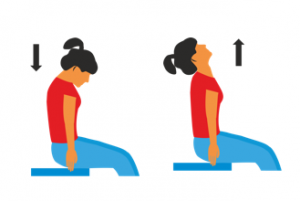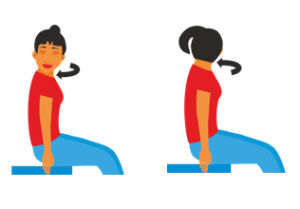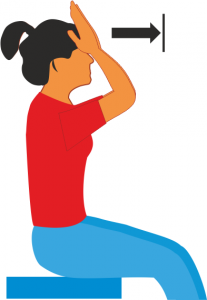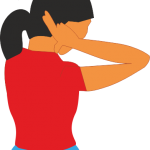Neck Exercises
NECK PAIN occurs due to disorders and diseases of any structure in the neck.
There are 7 neck bones and these bones are separated by rubber-like structures call discs. These discs sometimes slip backward and cause pressure on the spinal cord or nerves in the neck, resulting in pain in the neck or in the upper limbs. Disc prolapse/ bulge may cause pressure on the spinal cord.
CAUSES OF NECK PAIN
- Prolonged sitting at work: for eg. sitting in front of laptops or tablets or in front of improperly placed computers for hours without a break
- Constant sitting and unhealthy lifestyles
- Overuse of mobile phones
- Smoking/tobacco chewing
- Lack of exercise
- Uncontrolled diabetes
- High cholesterol and triglycerides
- Disc degeneration due to aging
- Wear and tear (arthritis) of joints in the spine
- Nerves getting pinched due to narrowing of the spinal canal
- Infection of the bones and discs in the neck (such as tuberculosis)
- Spinal tumors both benign and malignant tumors can cause neck pain
- Road accidents: whiplash injury which occurs due to forceful, rapid back-and-forth movement of the neck, like the cracking of a whip
- Viral infection of the throat causes swelling of the lymph nodes and neck pain
- Certain rheumatological conditions
- Fractures of the bones in the neck
SYMPTOMS
- Pain and stiffness in the middle or either side of the neck
- Pain radiating to the arms
- Numbness, pins, and needles or tingling sensation felt in the arm up to the fingers
- Dizziness when looking up or on turning the head
- Muscle spasms
- Headaches, chest pain, palpitations, breast pain, ringing in the ears.
- Weakness in the arms
- Difficulty lifting or gripping objects
- Loss of bladder or bowel control
- Loss of balance
- Altered walking pattern
PREVENTIONS
Neck pain can be prevented by
- Neck strengthening exercises
- Neck stretches
- Use desktops with large monitors
- Avoid sitting for more than 20 minutes-take frequent short walks at the workplace
- Use a standing desk
- Avoid overuse of neck braces/collars
- One hour of physical activity everyday-like swimming, cycling, jogging, running, walking or other sporting activities are very helpful in preventing recurring attacks of neck pain
- Yoga improves the flexibility of your joints
- Students should avoid carrying heavy school bags on one shoulder, minimize the time spent on I pads and mobile phones
- Take help while lifting or carrying heavy weights and lifting weights overhead
TREATMENTS
- Most neck pain is preventable
- Medications, physiotherapy help relieve your pain. This should be followed by regular exercises
- Sometimes, steroid injections given by Pain management specialists relieve the pain
- Only a small percentage of patients require surgery
SURGERY
Patients get significant relief from neck pain following surgery. The offending disc or bone pressing on the spinal cord and nerves is removed and the spine stabilized with plates and screws or rods and screws.
Artificial disc replacements are where the damaged disc is removed and replaced with an artificial disc is one of the surgical methods used for the treatment of neck pain.
NECK EXERCISES
General neck exercises that you can be done at home.
These exercises can help improve poor posture, gain muscle strength, and relieve some tightness.
Exercises should be done slowly and in a pain-free range.
- Sit upright in a chair and move the chin toward the chest, then back against the headrest, stretching the neck.

- Move the left ear toward the left shoulder, then the right ear toward the right shoulder. Repeat this pattern 5 times in each direction

- Turn your neck to the right and then to the left. Repeat 5 times.

2. Chin tucks
- Keep your neck in a relaxed position. Try to tuck your chin without holding your breath. You should feel a slight pull around the upper neck.
- Hold the position for 3 to 5 seconds, and gently bring your neck to a normal/ starting position. Perform this for 10 to 12 times a day.

3. Isometric neck exercises
These exercises can be done either in a sitting or standing position with knees hip-width apart. Keep shoulders relaxed
- Neck Flexing Exercise Put your hand on your forehead. Bring your head forward against the palm of your hand. Hold for 5 seconds. Repeat 5 times.

- Neck Extension Excercise Place your hand at the back of your head. Push the head backward. while pushing your palms forward. Hold for 5 seconds. Repeat 5 times.

- Side Bending Exercise Put your right hand on the right side of your head. Try to push against the palm. Hold for 5 seconds. Repeat 5 times. Repeat the same on the left side.

4. Shoulder Shrugs Exercise
- Sit upright in a chair with both feet touching the floor, knees are hip-width apart.
- Shoulders are in a relaxed position.
- Raise your shoulders up closer to your ears, hold for 5 counts, and return to the starting position. Repeat 10 times.

5. Shoulder Braces Exercise
- Sit upright in a chair with both feet touching the floor, knees are hip-width apart.
- Shoulders are in a relaxed position and arms straight in front of you.
- Pull your elbows behind towards the backrest, squeezing the shoulder blades together. Hold for 5 counts and return to the starting position.Repeat 10 times.

6. Neck Stretches
- Upper traps stretch Begin by retracting your head back into a chin tuck position. Next, move your head towards one side with the help of your hand. Hold 5 seconds. Repeat 5 times. Repeat with the opposite side.

- Levator scapulae stretch Place the arm on the affected side behind your back and use your other hand to draw your head downward and towards the opposite side. You should be looking towards your opposite pocket of the affected side. Hold for 5 seconds. Repeat 5 times. Repeat with the opposite side.

- Suboccipital stretch Gently bring your chin down towards your chest as your fingers assist in adding a stretch to the back of your head. Hold for 5 seconds.


